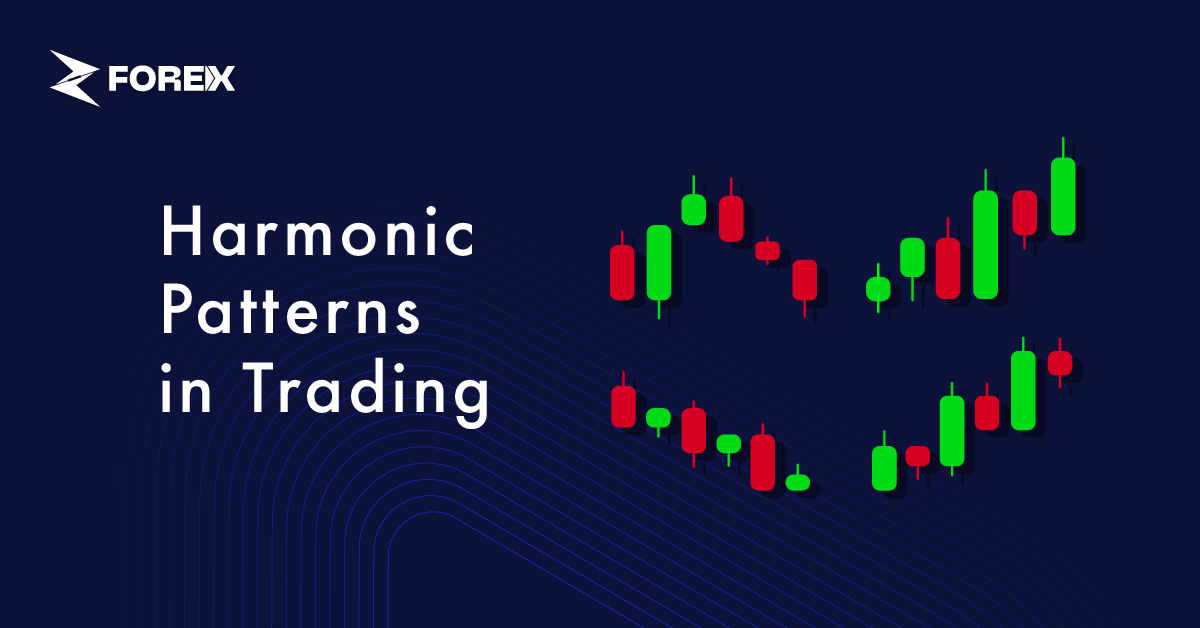
When harmonic patterns are used in conjunction with other tools in technical analysis, they offer unique advantages to traders. They often appear complex and challenging, yet they can be an effective tool for identifying trend reversals or continuations in the market when used correctly.
Harmonic patterns are based on price movements that follow a specific mathematical structure. Traders attempt to make highly accurate predictions in the markets using these mathematical arrangements.
In our article, you will find detailed information about harmonic patterns.
Harmonic patterns are an analytical method where price movements form predictable structures based on specific mathematical ratios. By using mathematical measurements such as Fibonacci ratios, they aim to identify potential reversal or continuation points in price.
Patterns are generally used not only to predict trend reversals but also to anticipate areas where the current trend may continue. When the price reaches a certain level, the pattern is considered complete, which is interpreted as a strong signal that the price is likely to reverse.
There are various harmonic patterns that traders can utilize to evaluate buying and selling opportunities. Below, you will find the most commonly used types by traders:
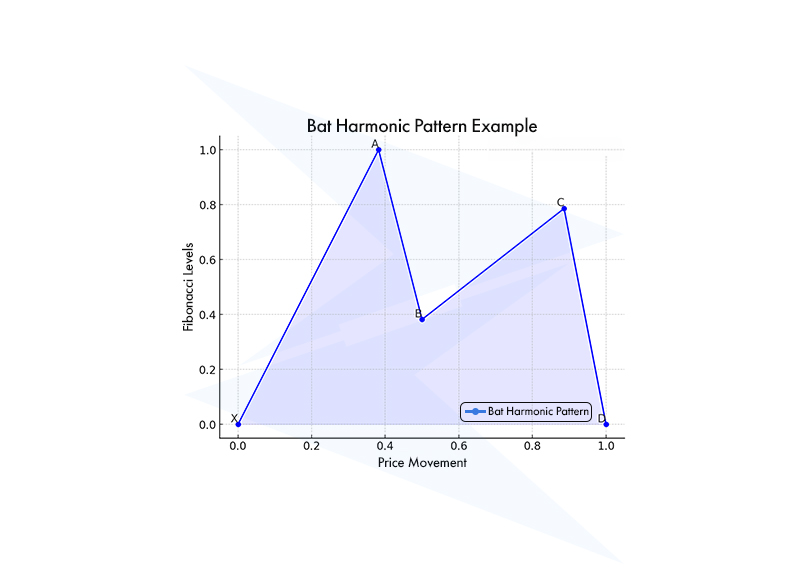
The Bat pattern is one of the most commonly used patterns in harmonic analysis. The pattern is particularly useful for accurately predicting price retracements in the direction of the trend.
As we can see in the above chart, the pattern is defined by the X, A, B, C, and D points. For the pattern to be complete, point D must reach the 0.886 Fibonacci retracement level. When the price reaches this level, a reversal is generally expected.
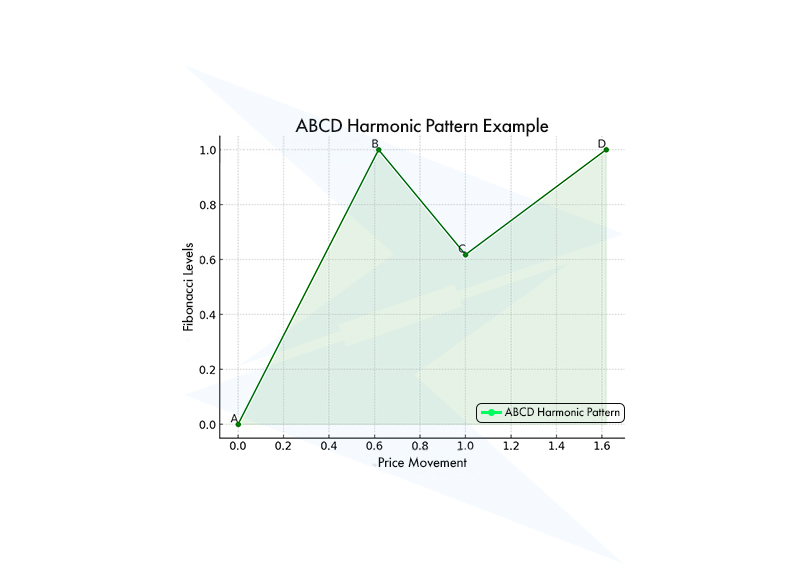
The ABCD pattern predicts that price movements will oscillate in a symmetrical manner, supported by specific Fibonacci levels. It is particularly used to identify levels where the price may correct in the direction of the trend or reverse.
The A-B movement is typically a strong price move, followed by the B-C movement, which is a corrective phase. The C-D movement is symmetrical to the A-B move, and point D is usually completed at the 1.618 Fibonacci extension of A-B.
Point D is generally considered an entry or exit signal for traders. When the price reaches point D, there is a high probability of the trend either continuing or reversing.
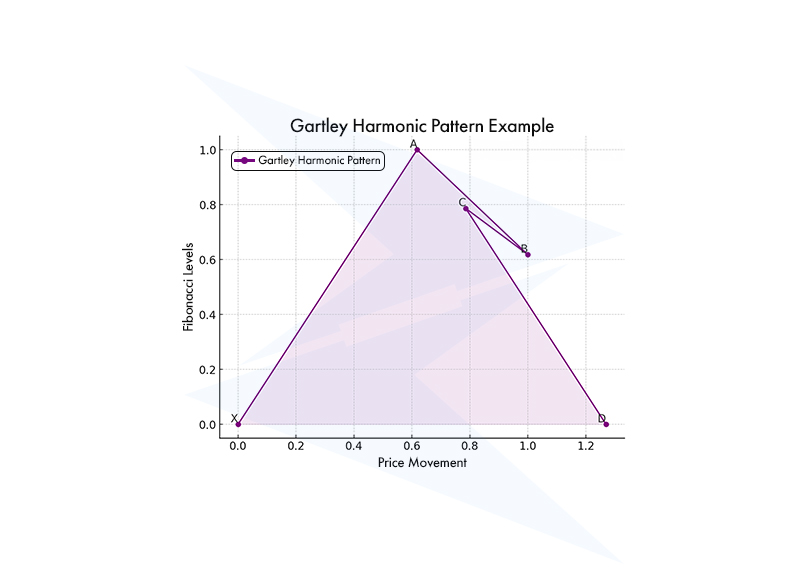
The Gartley pattern is used to forecast that prices would follow the trend after going through a certain correction phase. The points X, A, B, C, and D define the pattern.
The price usually goes through a stronger correction phase during the A-B movement and a weaker one during the B-C movement. The C-D movement is typically interpreted as an indication that the trend will continue. Point D should be around the 78.6% Fibonacci retracement level of the X-A move for the pattern to be complete.
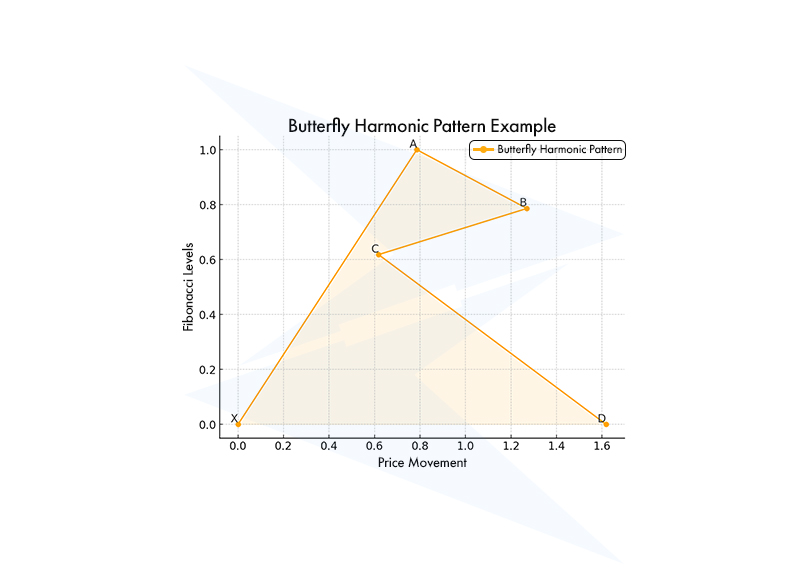
The Butterfly pattern represents one of the largest correction movements among harmonic patterns. The pattern relies on Fibonacci ratios to identify the points where the market will likely form a peak or a bottom.
The chart shows that the A-B movement denotes a correction phase in which the price reverts to the direction of the primary trend. The second phase of correction is the B-C movement, which is usually weaker.
The pattern's most important movement is the C-D one, and point D should be finished at the X-A move's 127% or 161.8% Fibonacci extension. The price is either in an overbought or oversold area based on these metrics.
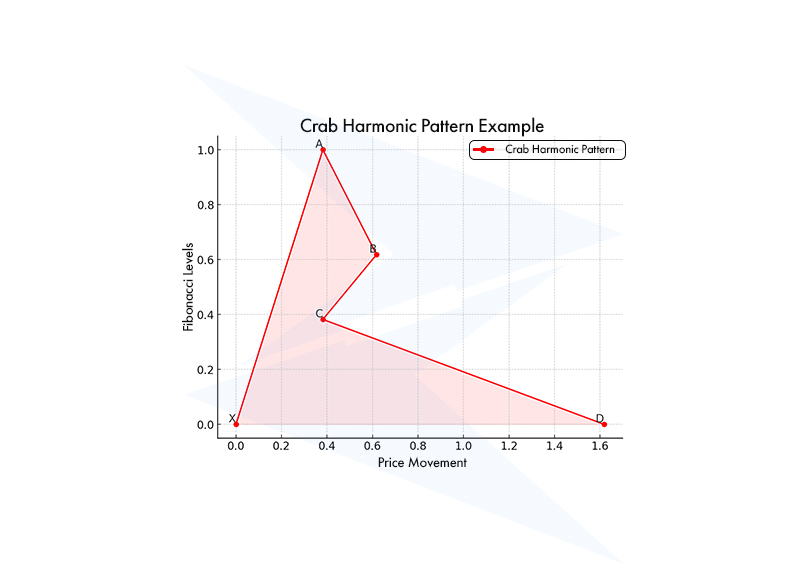
The Crab pattern predicts a strong price retracement followed by a sharp reversal. It is defined by the X, A, B, C, and D points.
The A-B movement represents a correction phase where the price pulls back, while the B-C movement shows a shorter correction. The C-D movement is the most critical part of the pattern.
Point D is expected to complete at the 161.8% Fibonacci extension of the X-A move. This high extension level indicates that the price has reached an overbought or oversold region, providing traders with a potential reversal signal.
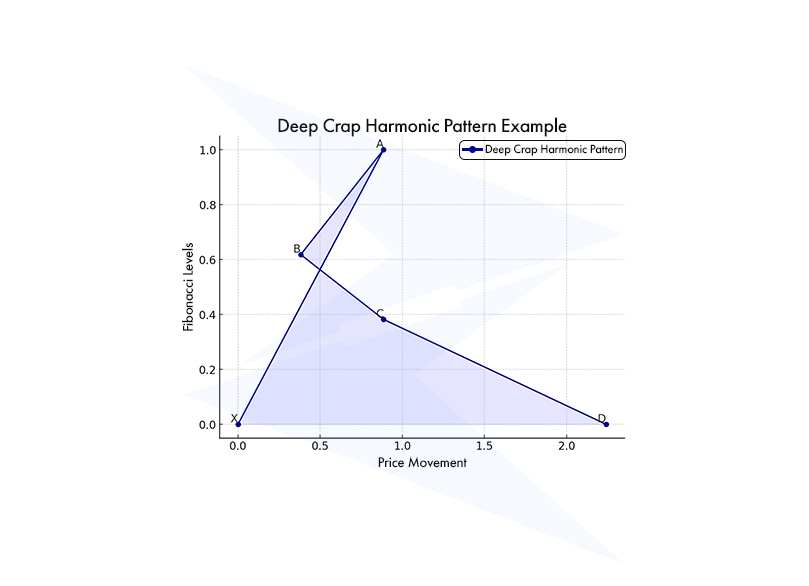
The Deep Crab pattern has a structure similar to the standard Crab pattern but involves a deeper Fibonacci retracement level. It offers opportunities to traders, especially during extreme market movements.
The price goes through a strong retracement during the A-B correction phase, but the B-C movement denotes a brief corrective. Point D is anticipated to finish at the X-A move's 224% Fibonacci extension. The price has reached extremely high levels, as indicated by this extension level.
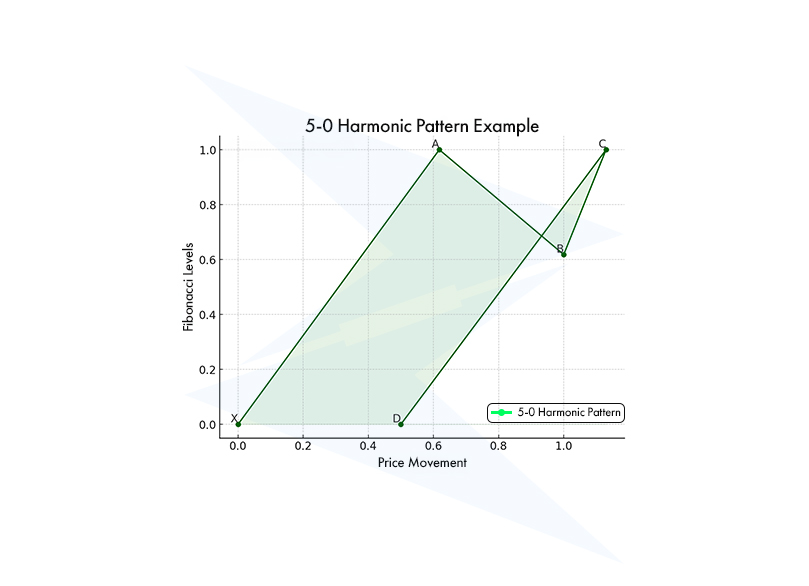
The 5-0 pattern has a structure that is different from other harmonic patterns. It particularly indicates that the market will enter a correction phase after a strong trend and then a new trend will begin.
A strong retracement in the direction of the primary trend is shown in the A-B movement. A temporary recovery is represented by the B-C movement. The C-D movement raises the prospect of establishing a fresh fashion trend. It usually closes at the X-A move's 50% Fibonacci retracement level.
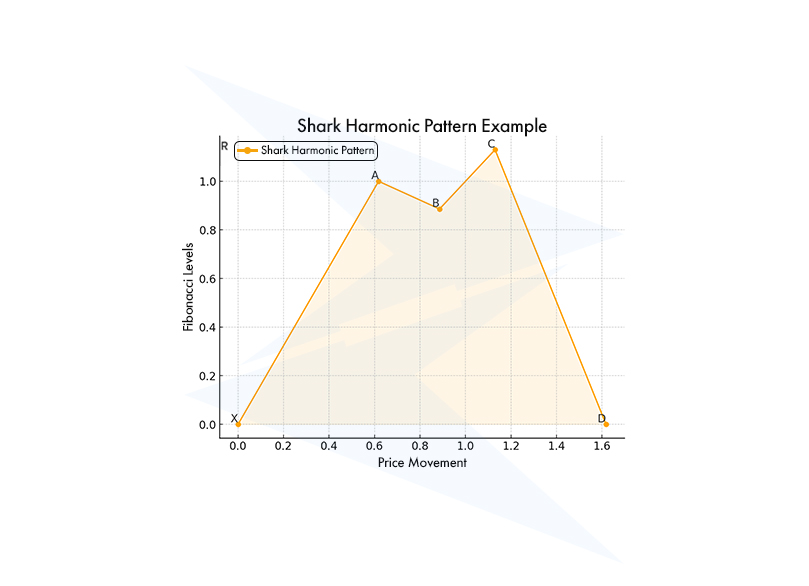
The Shark pattern is a relatively new structure in harmonic analysis and contains more flexible Fibonacci ratios compared to other patterns. This pattern is used to identify potential reversal points in the market during periods of extreme price volatility.
The A-B movement shows that the price has undergone a strong correction, while the B-C movement represents the price's attempt to recover. Point D is expected to complete at the 161.8% Fibonacci extension level of the X-A move.
The Shark pattern occurs faster than other harmonic patterns and works with high accuracy during short-term volatility periods in the markets.
What is the margin of error in harmonic patterns?
The margin of error in harmonic patterns varies depending on several factors. First, whether the trader can correctly identify the pattern plays a key role. Misapplication of Fibonacci ratios or using incorrect levels increases the margin of error.
Additionally, market conditions can affect the success of these patterns. During periods of high volatility, price movements can be more unpredictable, leading to misleading signals. Moreover, making trades before the pattern is complete can result in losses if the price unexpectedly changes direction.
How can I learn harmonic patterns?
You can learn harmonic patterns through various resources. Technical analysis books contain detailed sections explaining how harmonic patterns work, especially works by Scott Carney, which are considered helpful in this area. In addition to reading, practicing is key. Opening a demo account on platforms like zForex allows you to test your analyses without risking real money, helping you learn how to apply patterns under different market conditions.
How can I prevent false signals in harmonic patterns?
The best approach to prevent false signals is to avoid using harmonic patterns in isolation. Supporting the signals with other technical analysis tools creates a more reliable strategy. For example, combining patterns with oscillators like RSI (Relative Strength Index) helps identify overbought or oversold areas, allowing for better evaluation of the pattern's signals.
Additionally, paying attention to the trend direction is important. Aligning harmonic patterns with the overall trend helps filter out false signals. Volume indicators can also be used to confirm the validity of the pattern; patterns formed with low volume often generate weaker signals.
Why do harmonic patterns rely on Fibonacci ratios?
Fibonacci ratios indicate where prices might correct or reverse during a trend. Harmonic patterns use these ratios to predict specific correction levels or expansion points in the market. The reason harmonic patterns rely on Fibonacci ratios is that these ratios are frequently observed in both financial markets and nature. The Fibonacci sequence appears in many natural structures and formations, and price movements in financial markets tend to follow a similar order.
Are harmonic patterns suitable for short-term trading?
Harmonic patterns can be used for short-term trading, but they tend to produce more effective results in longer-term analysis. In short-term trades, market movements can happen quickly, increasing the risk of making trades before the pattern is completed. However, short-term traders can adjust the timeframe (e.g., using minute charts) to apply harmonic patterns, but they need to be more cautious and have quick decision-making abilities.
What are the most common mistakes in harmonic patterns?
Common mistakes in harmonic patterns include miscalculating Fibonacci levels. Correctly plotting the patterns requires accurate identification of Fibonacci ratios and retracement levels. Additionally, making trades before the pattern is complete can lead to potential losses for traders. Another frequent mistake is the visual misidentification of the pattern. Traders may incorrectly define the structure of a pattern or misinterpret its signals.
When do harmonic patterns fail?
Harmonic patterns can fail due to unexpected changes in market conditions. Unforeseen news, economic events, or sudden price movements can lead to the failure of a pattern. Furthermore, incomplete identification or incorrect use of the pattern also contributes to failure. For example, trading before the pattern is complete or misidentifying the pattern’s points can cause losses for traders.
How is the confirmation of harmonic patterns done?
Confirmation of harmonic patterns is typically done when the price reverses at the point where the pattern completes (point D). However, this reversal alone may not be sufficient; additional signals should be sought to confirm that the price will continue in the expected trend. For instance, RSI indicators reaching overbought/oversold levels or price action being supported by high volume can confirm the validity of the pattern.
Moreover, observing whether the price moves in the expected direction after the pattern completes is essential for confirmation. Such signals enhance the reliability of the pattern and provide traders with more confidence in opening positions.
 QuickTrade in cTrader: How to Place Trades Faster
QuickTrade in cTrader: How to Place Trades Faster
QuickTrade is a built-in cTrader feature that allows you to place trades directly from the chart, without opening the full order ticket.
Detail A Practical Guide to cBots on cTrader
A Practical Guide to cBots on cTrader
Discover cBots in the cTrader ecosystem, how they are added and used through cTrader Algo, and what to pay attention to when selecting a strategy.
Detail cTrader Shortcuts: 15 Tips to Upgrade Your Experience
cTrader Shortcuts: 15 Tips to Upgrade Your Experience
This guide highlights 15 practical shortcuts and settings that upgrade your cTrader experience.
DetailThen Join Our Telegram Channel and Subscribe Our Trading Signals Newsletter for Free!
Join Us On Telegram!